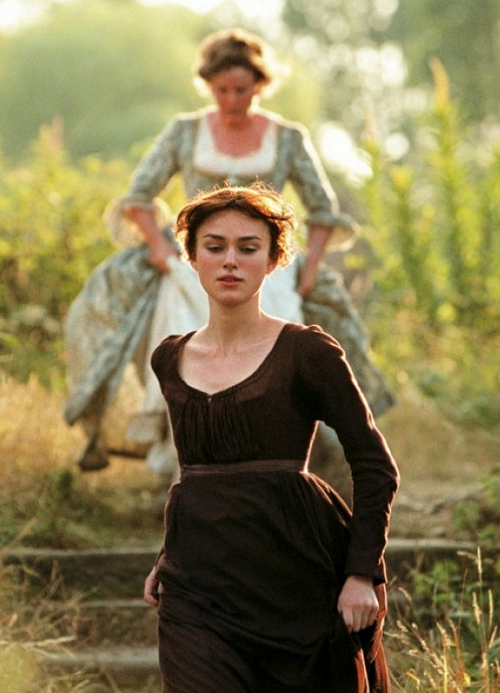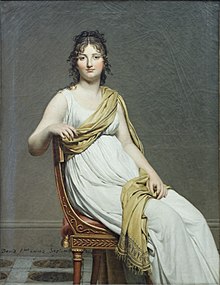
I love learning about Jane Austen’s life and the history of fashion during her time. I absolutely love the costumes in the movie adaptations of her work, but there is one question that I have always had: is it Regency, or Georgian?
Jane Austen’s books are set in the Regency era (1811-1820), which is a sub-period of the Georgian era (1714-1830s). Austen’s books were written during the few short years when high-waisted empire dresses with short sleeves and décolletté necklines reigned supreme in the fashion world. When long sleeves were introduced in evening dress, she wrote Cassandra:
I wear my gauze gown today long sleeves & all; I shall see how they succeed, but as yet I have no reason to suppose long sleeves are allowable. Mrs. Tilson has long sleeves too, & she assured me that they are worn in the evening by many. I was glad to hear this.
– Jane Austen, 1814

I have had my eye on a few books about regency fashion for a while, and I finally decided to buy them to hopefully help me answer this burning question of mine: is Jane Austen fashion Georgian or Regency?
Dress in the Age of Jane Austen: Regency Fashion by Hilary Davidson
Jane Austen’s England: Daily Life in the Georgian and Regency Periods by Roy Adkins
So, what exactly was the difference between Early Georgian and Regency fashions?

Until the Napoleonic Wars, France was the major influence on fashions in Britain and Europe. It was the custom of messengers known as les grandes couriers de la mode to deliver the latest French fashions to the great courts of Europe in person. Wearing designer creations, their costumes were analyzed from head to toe, then tried on and taken apart. Patterns were made from the resulting pieces. People who visited cities and returned home were plied with questions about the latest trends in fashions by those who stayed behind. Soon, fashion journals like La Belle Assemblée and Ackermann’s Repository of Arts appeared, presenting collections of fashions, home furnishings, and architectural plans to those who lived in the farthest reaches of England.

In the Georgian era, wide hooped skirts were still worn for appearances at court, but gowns became simpler, narrower, and more vertical as time went on. (In fact, the change in dress silhouettes was so dramatic that such a radical shift in style would not occur again until the flapper era and the jazz age over a century later.) Male attire also went through a dramatic change. Ruffles and ornate brocaded fabrics gave way to intricately folded neckcloths, simple shirts, stark jackets and leg-hugging breeches.
In Pride and Prejudice (2005), there is a huge difference between Mrs. Bennet’s style of gown and that of her daughters. This distinctly marks a clear shift in fashion trends.

Then, the French Revolution (1789-1799) marked a radical shift from the elegant, wide-skirted brocade gowns that were so prevalent for most of the 18th century to the streamlined, body-hugging, empire-waisted silhouettes of the Directoire Period that were inspired by classical antiquity. War and blockade during the Napoleonic Wars (1803-1815) disrupted any French-British imports or exports for 12 years, but British fashion embraced French style after Napoleon’s final defeat. One reason for thinner silhouettes is because it was more economical during wartime to use less fabric.
Classicism was a huge influence on art and fashion at the time. There was a reaction against Rococo frivolity, and people sought to return to nature as the Industrial Revolution began to change the landscape in drastic ways. Gothic style also influenced Regency fashion. From this we see the puffy paneled sleeves, ruff collars and ‘Spanish’ cloaks.

The Regency (1811-1820) is defined by strong clothing narratives. Waistlines rose and dresses turned white and flimsy, ornamented with fripperies borrowed from other times and cultures. Women’s heads retreated into bonnets; their bosoms were newly defined and uplifted.
Several long-lasting, major clothing changes emerged. Trousers replaced knee-breeches in the male wardrobe. Women’s stays retreated into underwear, and front-opening gowns became back-opening gowns. Cotton overtook linen as the plain fabric of choice. Embellished display disappeared from male dress, replaced by somber surfaces emphasizing the lines of good tailoring. British-manufactured textiles finally started surpassing desirable imported Asian cloths such as muslin, and made cheaper dress accessories more readily available to ordinary consumers.
Soooo, ‘Jane Austen fashion’ means a little bit of both. Georgian and Regency fashion overlaps, but hopefully this sheds a bit more light on the distinction between the two. Each Jane Austen film adaptation has their own interpretation of fashion at the time, but the great thing about Austen is that she never directly mentions a classical influence in her work, so it can be left up to interpretation. If you want to read more about Jane Austen fashion, click here.

